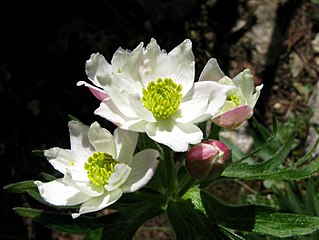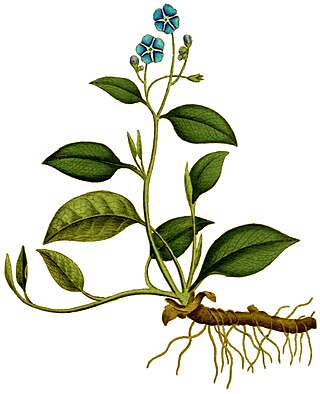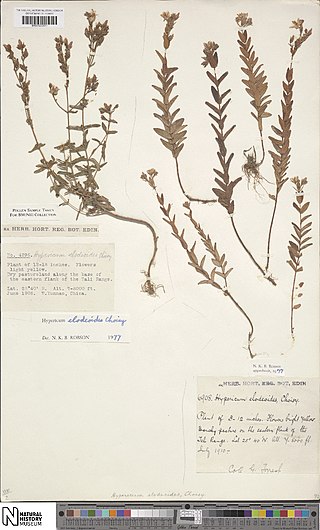
Umbilicus rupestris, the navelwort, penny-pies or wall pennywort, is a fleshy, perennial, edible flowering plant in the stonecrop family Crassulaceae in the genus Umbilicus so named for its umbilicate (navel-like) leaves.

Cornus canadensis is a species of flowering plant in the dogwood family Cornaceae, native to eastern Asia and North America. Common names include Canadian dwarf cornel, Canadian bunchberry, quatre-temps, crackerberry, and creeping dogwood. Unlike its relatives, which are for the most part substantial trees and shrubs, C. canadensis is a creeping, rhizomatous perennial growing to about 20 centimetres tall.

Narthecium ossifragum, commonly known as bog asphodel, Lancashire asphodel or bastard asphodel, is a species of flowering plant in the family Nartheciaceae. It is native to Western Europe, found on wet, boggy moorlands up to about 1,000 m (3,300 ft) in elevation. It produces spikes of bright yellow flowers in summer. The bright orange fruits have been used as a colourant to replace saffron by Shetland Islanders. Despite the plant's English name "bog asphodel", it is not particularly closely related to the true asphodels. In addition to other forms of pollination, this plant is adapted to rain-pollination. The Latin specific name ossifragum means "bone-breaker", and refers to a traditional belief that eating the plant caused sheep to develop brittle bones. The probable origin of this story is that sheep eating a calcium-poor diet are likely to develop bone weakness, and N. ossifragum favours acidic low-calcium soils.

Pulmonaria longifolia, is a semi-evergreen clump-forming herbaceous perennial plant, native to western Europe, including Britain, France, Spain, Portugal. It grows in semi-shaded habitats, such as woodland and scrub, to 2000 m above sea level.

Araujia sericifera is a perennial vining plant in the genus Araujia, of the family Apocynaceae, that is native to South America. The species was described in 1817 by the Portuguese botanist Félix de Avelar Brotero. The synonym Araujia hortorum is in more frequent use in New Zealand. Its common names include moth plant, white bladderflower, common moth vine, cruel vine, and false choko.

Lamium maculatum is a species of flowering plant in the family Lamiaceae, native throughout Europe and temperate Asia.

Eremophila oppositifolia, commonly known as weeooka, twin-leaf emu bush and mountain sandalwood, is a plant in the figwort family, Scrophulariaceae, and is endemic to Australia. It is a shrub or small tree with its leaves arranged in opposite pairs and has cream to red or sometimes maroon coloured flowers. It occurs in all mainland states, but not the Northern Territory.

Anemonastrum narcissiflorum, the narcissus anemone or narcissus-flowered anemone, is a herbaceous perennial in the genus Anemonastrum and the buttercup family. Basionym: Anemone narcissiflora Hook. & Arn.

Festuca rubra is a species of grass known by the common name red fescue, creeping red fescue or the rush-leaf fescue. It is widespread across much of the Northern Hemisphere and can tolerate many habitats and climates. It is best adapted to well-drained soils in cool, temperate climates; it prefers shadier areas and is often planted for its shade tolerance. Wild animals browse it, but it has not been important for domestic forage due to low productivity and palatability. It is also an ornamental plant for gardens.

Campanula rapunculoides, known by the common names creeping bellflower, rampion bellflower, rover bellflower, garden bluebell, creeping bluebell, purple bell, garden harebell, and creeping campanula, is a perennial herbaceous plant of the genus Campanula, belonging to the family Campanulaceae. Native to central and southern Europe and west Asia, in some parts of North America it is an extremely invasive species.

Omphalodes (navelwort) is a genus of flowering plants in the family Boraginaceae, widely distributed in the temperate Northern Hemisphere. In spring they produce blue or white flowers similar to forget-me-nots.

Anemonoides blanda, syn. Anemone blanda, the Balkan anemone, Grecian windflower, or winter windflower, is a species of flowering plant in the family Ranunculaceae. The species is native to southeastern Europe and the Middle East. The specific epithet blanda means "mild" or "charming". The genus name is derived from the Greek word anemos, or wind.

Iberis umbellata, common name garden candytuft or globe candytuft, is a herbaceous annual flowering plant of the genus Iberis and the family Brassicaceae.

Omphalodes cappadocica, the Cappadocian navelwort, is a species of flowering plant in the family Boraginaceae, native to woodland habitats in Turkey. It is an evergreen perennial growing to 25 cm (10 in) tall by 40 cm (16 in) wide, with slightly hairy, oval pointed leaves and loose terminal racemes of bright blue flowers with white eyes, similar to forget-me-nots, appearing in spring.

Hesperocodon hederaceus, synonym Wahlenbergia hederacea, also known as the ivy-leaved bellflower, is a species of flowering plant that is found throughout Europe. It is the only species in the genus Hesperocodon. The delicate, patch-forming, hairless perennial herb has thin, creeping stems about 20 cm in length. Its pale green leaves are long-stalked and have an ivy-shaped, rounded structure. These leaves can be described as having a cordate shape and are approximately 5–12 mm long and wide. The plant has erect, solitary, pale blue flowers in summer and autumn, with bell-shaped corolla with 5 short lobes. The flowers are 6–10 mm long x 5–8 mm wide and sit on fine stalks 1–4 cm long. It is suggested that the long pedicels are an adaptation to assist in seed dispersal.

Eremophila pterocarpa, commonly known as silver poverty bush or winged-fruited eremophila, is a plant in the figwort family, Scrophulariaceae and is endemic to Western Australia. It is a densely foliaged, upright shrub with most of its parts covered with a silvery powder.

Rubus tricolor is an evergreen prostrate shrub, native to southwestern China. Leaves are dark green above, pale green below, and stems have red bristles. It has white flowers in summer and edible red fruit. It grows approximately 0.3 m (0.98 ft) high and usually forming a vigorously spreading, dense mat. In cultivation, it is mainly used as groundcover. Common names include Chinese bramble, groundcover bramble, creeping bramble, Korean raspberry, Himalayan bramble, and groundcover raspberry. In Chinese, it is called 三色莓.
Mimophytum is a genus of flowering plants in the family Boraginaceae. The species occur in Northeastern Mexico and adjacent areas of Texas, United States. They are similar to the closely related genus Omphalodes but a distinct group.

Hypericum elodeoides, commonly called the Himalayan St. John's Wort, is a species of flowering plant of the St. John's wort family (Hypericaceae).

Myosotis albiflora is a species of flowering plant in the family Boraginaceae, native to southern Chile and Argentina. This species was described by Joseph Banks and Daniel Solander in Joseph Dalton Hooker's 19th century work Flora Antarctica. Plants of this species of forget-me-not are perennial and have white corollas. It is one of two native species of Myosotis in southern South America, the other being M. antarctica.

























